YBB Capital: Modular Blockchain - A new perspective on functional layer disputes and DA economics
Original author: Zeke, YBB Capital
Preface
The triangular dilemma of blockchain has always been an insurmountable gap in the industry in the past, and successive public chain projects have always tried to cross this gap through the design of different architectures and become the so-called Ethereum killer. However, the truth is cruel. Over the years, Ethereum’s status has never been surpassed by one person, and the impossible triangle of blockchain remains unbreakable. So is there a way to fill the gaps in the public chain and fill the impossible triangle? This is where Mustafa Albasan’s idea for modular blockchain originated.
The origins of modularity
The birth of modular blockchain stems from two white papers. In 2018, Mustafa Albasan and Vitalik co-authored a paper called Data Availability Sampling and Fraud Proofs. The paper describes a system that reduces the trade-off between on-chain capacity and security by allowing light clients to receive and verify fraud proofs from full nodes, and designing a data availability proof system without sacrificing security and decentralization. Next, solve the scalability of blockchain.
Then in 2019, when Mustafa Albasan wrote the Lazy Ledger white paper, he detailed a new architecture in which the blockchain was only used to sort and ensure the availability of transaction data, and was not responsible for the execution and verification of transactions. The purpose of this architecture is to solve the scalability issues of existing blockchain systems. At the time, he called this a smart contract client.
The execution of smart contracts is executed on this client through another execution layer. This is the prototype of Celestia. The emergence of Rollup later made this idea more certain. Because the logic of Rollup is to execute smart contracts off-chain, and then aggregate the results into proofs and upload them to the execution layer of the client.
By reflecting on the architecture of blockchain and new expansion technologies, he defined a new paradigm and called it Modular Blockchain.
What is modular blockchain
The architecture of traditional monolithic blockchains usually consists of four functional layers:
Execution layer - The execution layer is mainly responsible for processing transactions and executing smart contracts. It includes transaction verification, execution and status updates;
Data-availability layer - The data-availability layer in a modular blockchain is responsible for ensuring that data in the network can be accessed and verified. It usually includes functions such as data storage, transmission and verification to ensure the transparency and trust of the blockchain network;
Consensus layer - Responsible for the agreement between nodes to achieve consistency of data and transactions in the network. It verifies transactions and creates new blocks through a specific consensus algorithm, such as Proof of Work (PoW) or Proof of Stake (PoS);
Settlement layer - Responsible for completing the final settlement of transactions, ensuring that the transfer and records of assets are permanently stored on the blockchain, and determining the final state of the blockchain.
The monolithic blockchain integrates the work of these components into the same system. This highly integrated design will inevitably lead to some inherent problems, such as poor scalability, poor flexibility, and difficulty in maintenance and updates.
Celestia believes that monolithic blockchains no longer need to do everything themselves. The future evolution of Web3 will be modular blockchain, by making the blockchain modular and distributing its processes into multiple exclusive layers, each of which is responsible for handling a specific functional layer. Create a better system that is independent, secure, and scalable.
Modular design principles
A design is modular if it breaks the system down into smaller parts that can be swapped or replaced. The core idea is to focus on doing only some things well (the operation of a portion or a single functional layer) rather than trying to do everything. If we use projects we are familiar with in the past as examples, Cosmos Zones and Polkadot Parachains can actually be regarded as a type of modularity.
new perspective
Based on the new perspective of modularity, the space for redesigning the monolithic blockchain and its modular stack will be greatly improved. Modular blockchains with different specific uses and architectures can be combined to work together. With the possibility of diverse designs, this track has also given birth to many interesting innovative projects. The following will discuss the current controversy about different functional layers and how Celestia interprets modularity from a modular perspective.
An execution layer centered around Ethereum
If we think of Rollup as a modular execution layer, we will find that almost all modular execution layer projects are built on Ethereum. The reason is naturally self-evident. Ethereum has a large amount of resources as a moat and is the most decentralized among the options. However, its scalability is very poor, so it has great potential in redesigning the functional layer. . From the dismal performance of the recently launched Move-based language public chains (Aptos, Sui) compared to the unprecedented success of Layer 2 on Ethereum, it is not difficult to see that the infrastructure narrative of the blockchain has also shifted from being a public chain to being a Layer 2 of Ethereum. So is the existence of modularity a good thing or a bad thing? Has the execution layer centered around Ethereum stifled public chain innovation?
Blockchain expansion picture
First, from the perspective of the execution layer, the existing chains are reclassified. Nosleepjons article Twin Suns of Tatooine is quoted here to explain the current execution layer classification of blockchain.
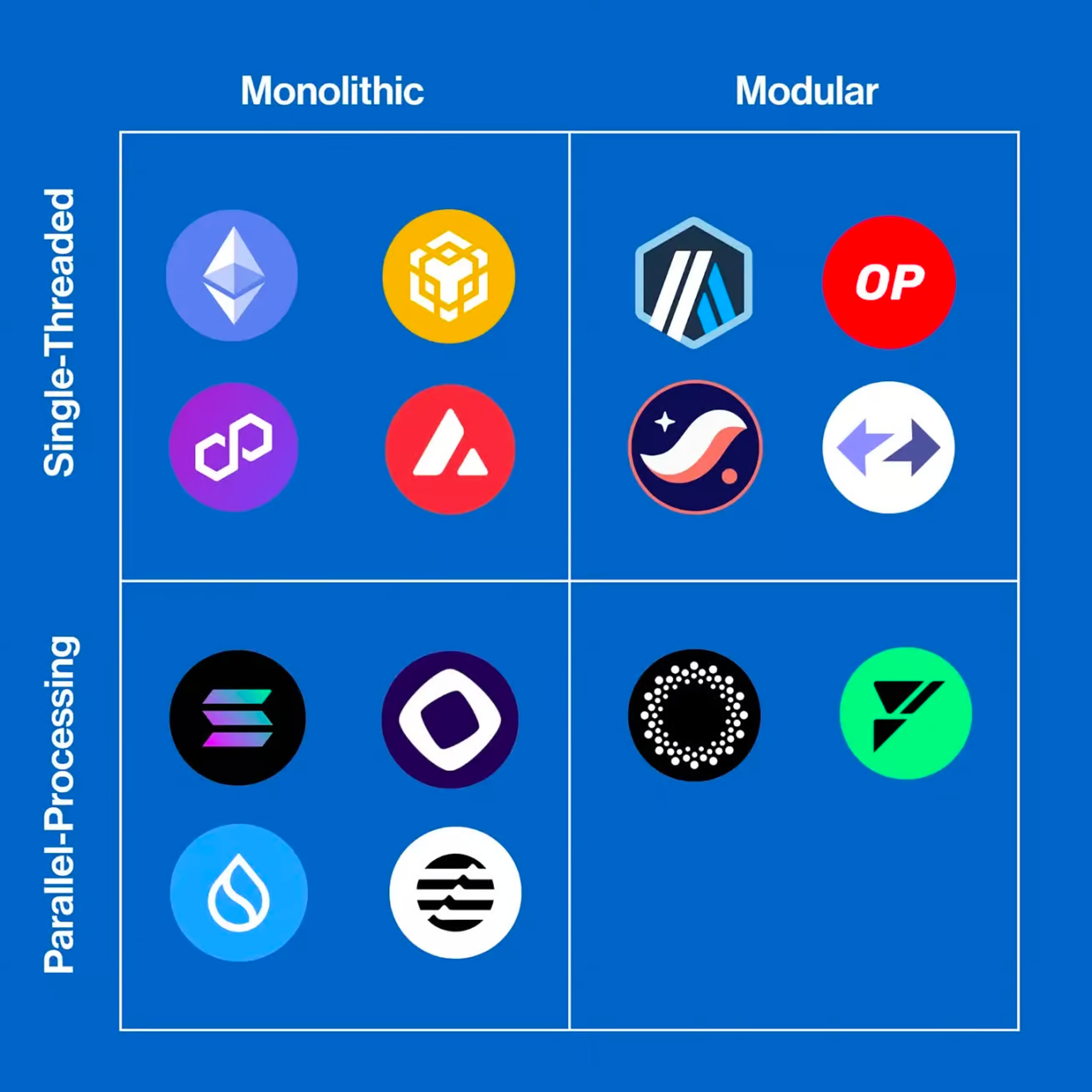
Current blockchains can be divided into four categories:
1. Single-threaded monolithic blockchain: a monolithic blockchain that processes one transaction at a time. Due to limitations, most of them have moved to rollup or horizontal scaling roadmaps.
Representative projects: Ethereum, Polygon, BNB Chain, Avalanche
2. Parallel processing of monolithic blockchain: a single blockchain that processes multiple transactions at one time.
Representative projects: Solana, Monad, Aptos, Sui
3. Single-threaded modular blockchain: A modular blockchain that processes one transaction at a time.
Representative projects: Arbitrum, Optimism, zkSync, Starknet
4. Parallel processing modular blockchain: A modular blockchain that processes multiple transactions at once.
Representative projects: Eclipse, Fuel
Monolithic parallel processing architecture VS modular architecture
There are currently many opinions on which solution to adopt, especially the contrast between the two concepts of modularization and overall parallel processing. There are also three types of camps:
Modular camp: Modularity advocates (mostly also Ethereum advocates) believe that it is impossible for a monolithic blockchain to solve the impossible triangle of blockchain. Only by building Lego on Ethereum can we achieve scalability while having security and decentralization features. And modularity allows for more control and customizability.
Single-chip parallel processing camp: This camp (quoting the views of Kodi and espresso in Single-chip VS Modularity: Who is the future of blockchain?) believes that new public chain architectures with single-chip parallel processing (Move system, Solona, etc. ) has a high degree of integration, and the overall performance will be better than the modular fragmented design. Moreover, the modular architecture is not safe, especially since it requires a large amount of cross-chain communication, and the attack surface of hackers is wider.
Neutral camp: Of course, there are also those who hold a neutral attitude and believe that the two can eventually coexist. For example, Nosleepjon believes that the end game of this game is: both have their own advantages, competition between public chains will still exist, and Rollup will compete with each other.
EndGame
The focus of this issue can actually be simplified to whether the frictional disadvantages of modularity (cross-chain insecurity, system instability, etc.) are greater than the centralization problem of the new public chain. Looking at this controversy from the market perspective, whether it is the flaws of the Rollup centralized sequencer or the possible dangers of cross-chain bridges, it has not made people switch to new public chains. It is because these problems currently seem to have room for improvement, but the new public chain cannot replicate the huge ecological moat and decentralization advantages of the Ethereum chain.
On the other hand, although the new public chain has advantages in performance and integration in terms of architecture, ecologically it is a simple fork of the Ethereum ecosystem, with too high a degree of homogeneity and a lack of liquidity. There is no exclusive application that can reflect its own architectural advantages, and naturally there is no reason why people have to give up the Ethereum ecosystem. The plasticity of Rollup is high enough, and there is still a lot of room for improvement of Rollup in new architectures in the future. When Rollup also has most of the advantages of non-EVM chains, it will be difficult for Solana Summer to happen in the future. So on this issue, I think the friction disadvantages of modularity are smaller than the centralization problem of public chains. And the neutral situation does not seem to exist. The siphon effect of Ethereum will be like the iPhone, attracting a large number of developers who focus on scalability to the second layer, and the new public chain will become a ghost town.
Regarding the future of infrastructure, I am undoubtedly more inclined to modularity. Ethereum’s diversified expansion will also be the beginning of the public chain game EndGame. Layer 2 will compete for general chains, and Layer 3 will compete for super application chains.
The current situation of projects being financed in the primary market also confirms this. Except for a large number of Ethereum second-layer projects, which are Bitcoin expansion projects, there are almost no new public chains.
But then again, the industry has always been built on Ethereum, and the current trend is a bit over-centralized. Is this status quo really good? Lack of competition will stagnate the development of an industry. The industry needs diversity and more choices. But so far we have not seen any signs of how the new public chain can create a breakthrough. While Ethereum continues to improve its own shortcomings, how to find larger gaps to carry out precise strikes is a key issue that non-EVM systems need to consider.
Arena of DA Programs
After talking about the disputes at the execution layer, let’s look at the disputes at the data availability layer (DA layer). The debate about which data availability solution Rollup should adopt has been a hot topic in the industry recently. The cause was a post by Dankrad Feist, a researcher at the Ethereum Foundation. Tweets discussed related aspects. And it is clearly stated in the opinion that Rollup that does not use Ethereum DA is not Layer 2. So will the past Layer 1 wars evolve into a war between orthodox (using Ethereum DA) Layer 2 and unorthodox Layer 2? So currently there are three main solutions for DA in the industry:
1. Public chain as settlement layer
Taking Ethereum as an example, the fees submitted to Ethereum when conducting a transaction in Rollup mainly include the following categories:
Execution Fee: Compensation for the computing resources required to execute transactions. It includes the gas fee required to execute a transaction and is usually proportional to the transactions complexity and execution time. In Rollup, execution fees may include fees for executing transactions off-chain, as well as fees for generating and verifying transaction proofs;
State Fee: State fee is related to updating the state on the Ethereum main chain. In a rollup, this includes the cost of committing the new state root to the main chain. Whenever the Rollup aggregator generates a new state root and commits it to the main chain, state fees are incurred. This cost may be proportional to the frequency and complexity of status updates;
Data Availability Fee: The fee for publishing data to Layer 1.
Data availability fees account for the largest proportion of these fees, and the fees are high. For example, on May 6 this year, Arbitrum paid a sky-high gas fee of 376.8 ETH to Ethereum in a single day due to the surge in gas fees of Ethereum.
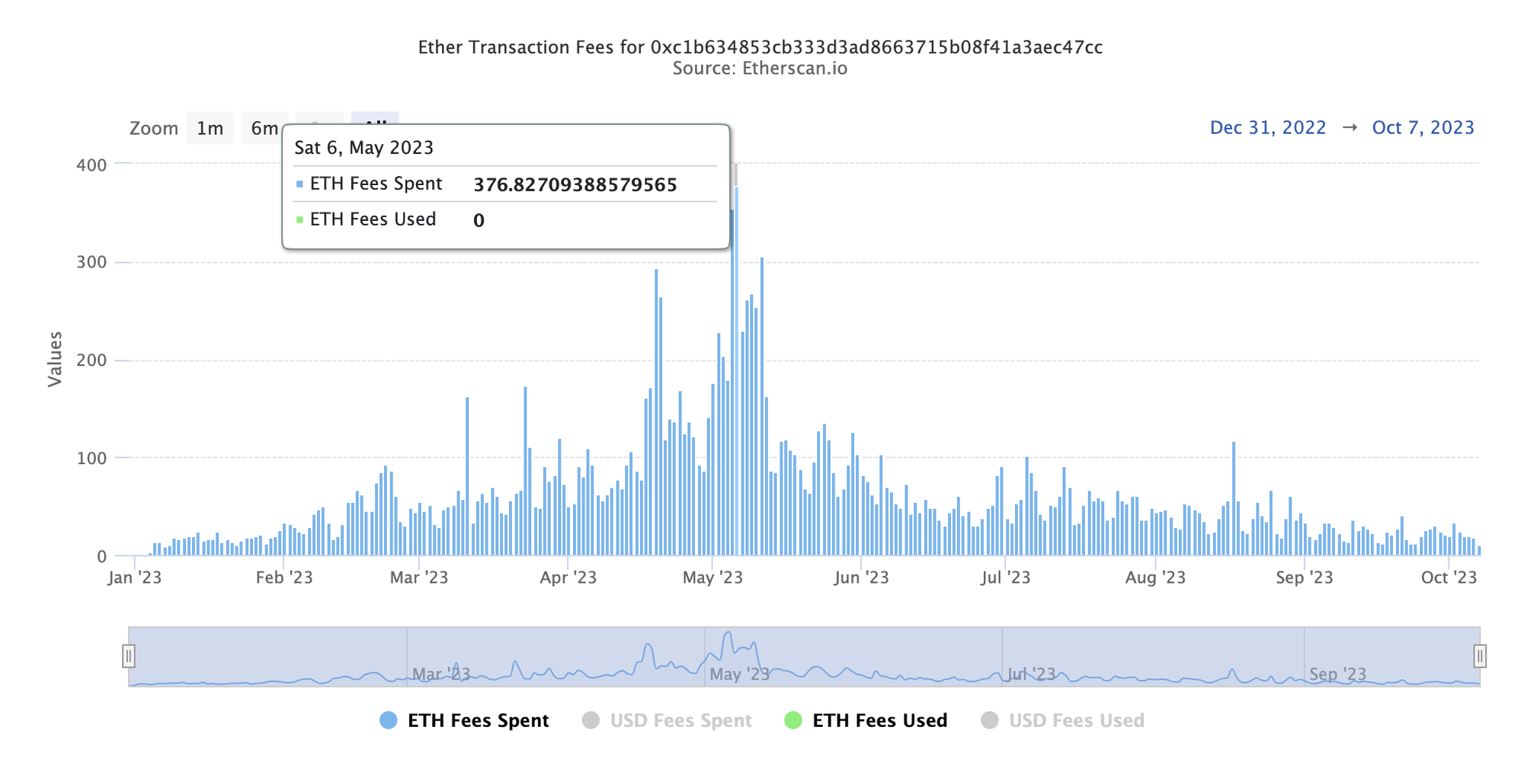
This is because Rollup uses Calldata when uploading data to Ethereum and stores the data permanently, so it is very expensive. But the advantage is to have the best security and legitimacy of the three options. The current cost reduction of this option needs to wait for the EIP-4844 update of the Cancun upgrade. By introducing the Blob carrying Transactions transaction format. Compared with the ordinary transaction format, the transaction format has one more Blob location that can be used to store Layer 2 data. Moreover, Blob data will be deleted by the node after one month, thus significantly saving storage space.
Blob is a transaction format that provides cheaper data availability than Calldata. There are two main reasons: on the one hand, Callda exists in the Execution Payload, and Blob data is stored in the Prysm node or Lighthouse node (rather than in Geth). In comparison, the resources consumed when Calldata needs to be read by the contract Much more; on the other hand, Blob data is short-term storage and the node will delete the Blob data after one month. But its gas cost will still be higher than the latter two options.
2. Validiums DA mode
For application chain type Rollups (such as the former dYdX, Immutable, etc.), they usually use the second-layer scalability engine launched by the head Rollup project (the most common one currently is StarkEx, but the head project of the ZK series have similar plans). In DA mode, due to the larger amount of calculations in the application chain, they prefer to use Validiums, a low-cost, high-throughput solution. Validiums are designed to take advantage of off-chain data availability and computation, similar to ZK-Rollup, by issuing zero-knowledge proofs to verify off-chain transactions on Ethereum. However, unlike ZK-Rollup which keeps the data on-chain, Validiums keeps the data off-chain and is 90% cheaper than using Ethereum, making it the most cost-effective solution given the choice.
But because the data remains off-chain, Validium’s physical operators can freeze users’ funds. To prevent extreme situations from occurring, a Data Availability Committees (DAC) scheme must be introduced. The DAC must confirm that it has received the data by signing each update to the status through its quorum. This is a controversial approach because you first have to trust the security of the entity rather than the chain. This scheme was directly named in a tweet by Dankrad Feist (the author of EIP-4844 above).
3. Modular DA
From a modular perspective, there are many ways to redesign the DA layer, which may lead to large differences in the specific implementation methods of different projects. Therefore, a detailed description of the modular DA project requires a lot of space. Here, Celestia is represented as a description of the DA project.
Celestia
Continuing from the beginning of the article, as the first proposer of the concept of modular blockchain, Celestia is the most well-known and earliest project in this track. Its vision aims to solve the problems of blockchain scalability and modularity. Celestia provides developers with more flexibility, making it easier to deploy and maintain blockchain applications. At the same time, it is also reducing the cost and complexity of deploying blockchain, providing dApp creators and blockchain developers with a modular, scalable blockchain architecture to support the needs of various applications and services.
Working principle and structure
Decoupled execution: Celestia’s logic is to separate the protocol into different layers, each focused on a specific functionality, and these layers can then be recombined to build blockchains and applications. Celestia focuses on the consensus and data availability layers in the hierarchy. Similar to some Layer 1s, Celestia uses the Byzantine Fault Tolerance (BFT) consensus algorithm Tendermint for transaction ordering, but it is different from other Layer 1s. Celestia does not reason about transaction validity, nor does it execute transactions. It only performs packaging, sorting, and broadcasting of transactions. All transaction validity rules are enforced by Rollup nodes on the client (i.e., decoupling the consensus layer and execution layer). Then pay attention to a key point, do not reason about transaction validity. That is, malicious blocks that conceal transaction data can also be published on Celestia. So how should the verification process be implemented? Celestia introduces two cores here, two-dimensional Reed-Solomon coding and Data Availability Sampling (data availability sampling, referred to as DAS).
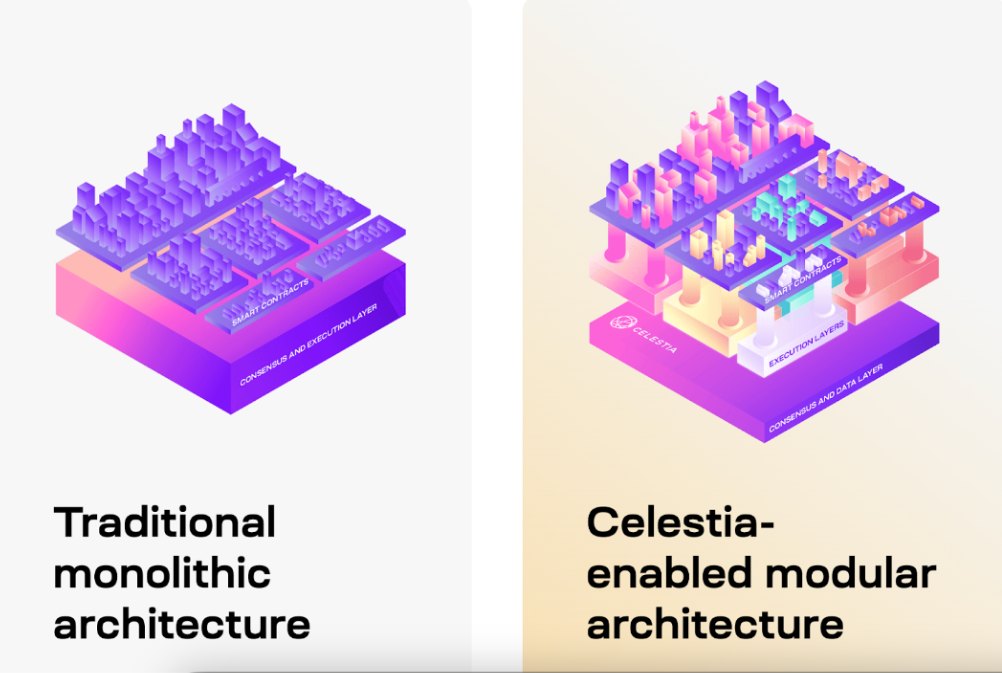 Overall architecture of monolithic blockchain compared to Celestia’s modular architecture
Overall architecture of monolithic blockchain compared to Celestia’s modular architecture
DAS:This scheme is used by light nodes to verify the availability of block data. This method does not require nodes to download the entire block. Only part of the data of the sampling block is needed (the specific implementation requires two-dimensional Reed-Solomon encoding, which will be explained in detail below). Unlike the DAC mentioned above, DAS does not need to trust the security of the entity. It only needs the chain to be decentralized enough so that the data can be trusted.
Two-dimensional Reed-Solomon coding (erasure coding):The basic idea of two-dimensional Reed-Solomon coding is to apply Reed-Solomon coding to both rows and columns respectively. This way, even if errors occur in certain rows and columns of the 2D data, they can be corrected. Then by encoding the block data, the block data is divided into kk blocks, arranged into a kk matrix, and expanded into a 2 k 2 k extended matrix through multiple Reed-Solomon encodings. Compute 4 k independent Merkle roots of the rows and columns of the expansion matrix; the Merkle roots of these roots are used as the block data commitment in the block header. Celestia light nodes sample 2k 2k data blocks. Each light node randomly selects a set of unique coordinates in the expansion matrix and queries the full node for data blocks about these coordinates and the corresponding Merkle proofs. Every received block of data with a correct Merkle proof is broadcast to the network.
If you understand it abstractly, you can also say that the block data is divided into a square matrix (for example, 8 x 8), and through encoding, additional check rows and columns are added to the original data to form a larger square matrix ( 16 x 16). By randomly sampling some of the data in this large matrix and verifying its accuracy, the integrity and availability of the overall data can be ensured. Even if part of the data is lost or damaged, the entire block of data can still be recovered using the check data.
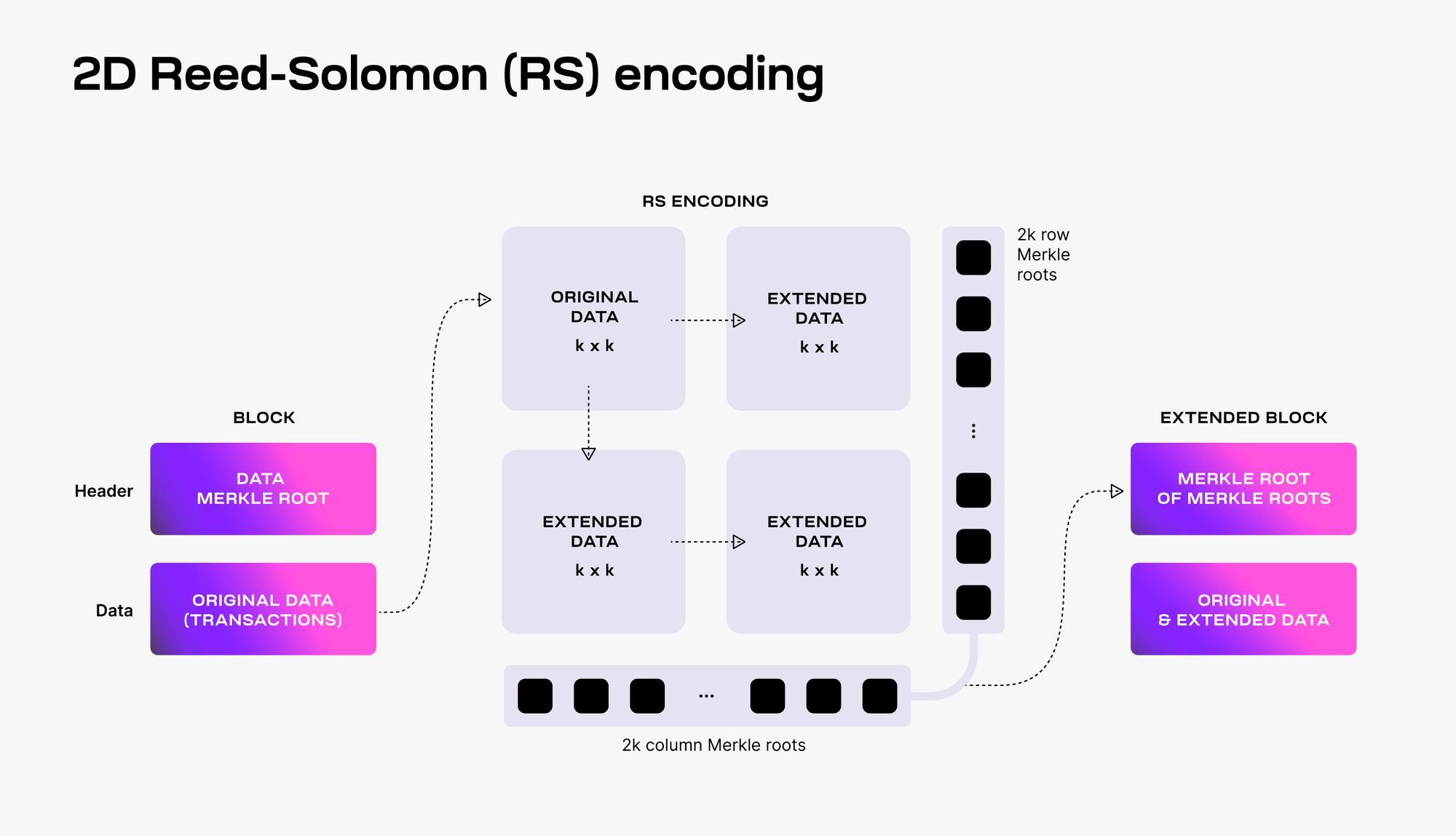
Block scaling:Celestia scales as the number of light nodes increases. Celestia will remain secure as long as there are enough nodes on the network to sample entire blocks. This means that as more nodes join the network for sampling, the block size can be increased accordingly without sacrificing security or decentralization. Doing this on a traditional blockchain would sacrifice decentralization, as larger block sizes would add greater hardware requirements for nodes to download and verify data.
Sovereignty Rollup:This is also a concept pioneered by Celestia, combining elements of various blockchain designs, including Layer 1 blockchains, Rollup, and early Bitcoin networks like Mastercoin. The key difference between sovereign rollups and smart contract rollups (OP, ARB, ZKS, etc.) is how transactions are verified. In smart contract rollup, transactions are verified by smart contracts on Ethereum. In contrast, in a sovereign rollup, the nodes of the rollup itself validate transactions.
A sovereign rollup publishes its transactions to another blockchain (such as Celestia) for ordering and data availability. The sovereign rollup node then determines the correct chain. This design allows a sovereign rollup to inherit several security aspects from the data availability (DA) layer, including liveness, security, reorganization resistance, and censorship resistance.
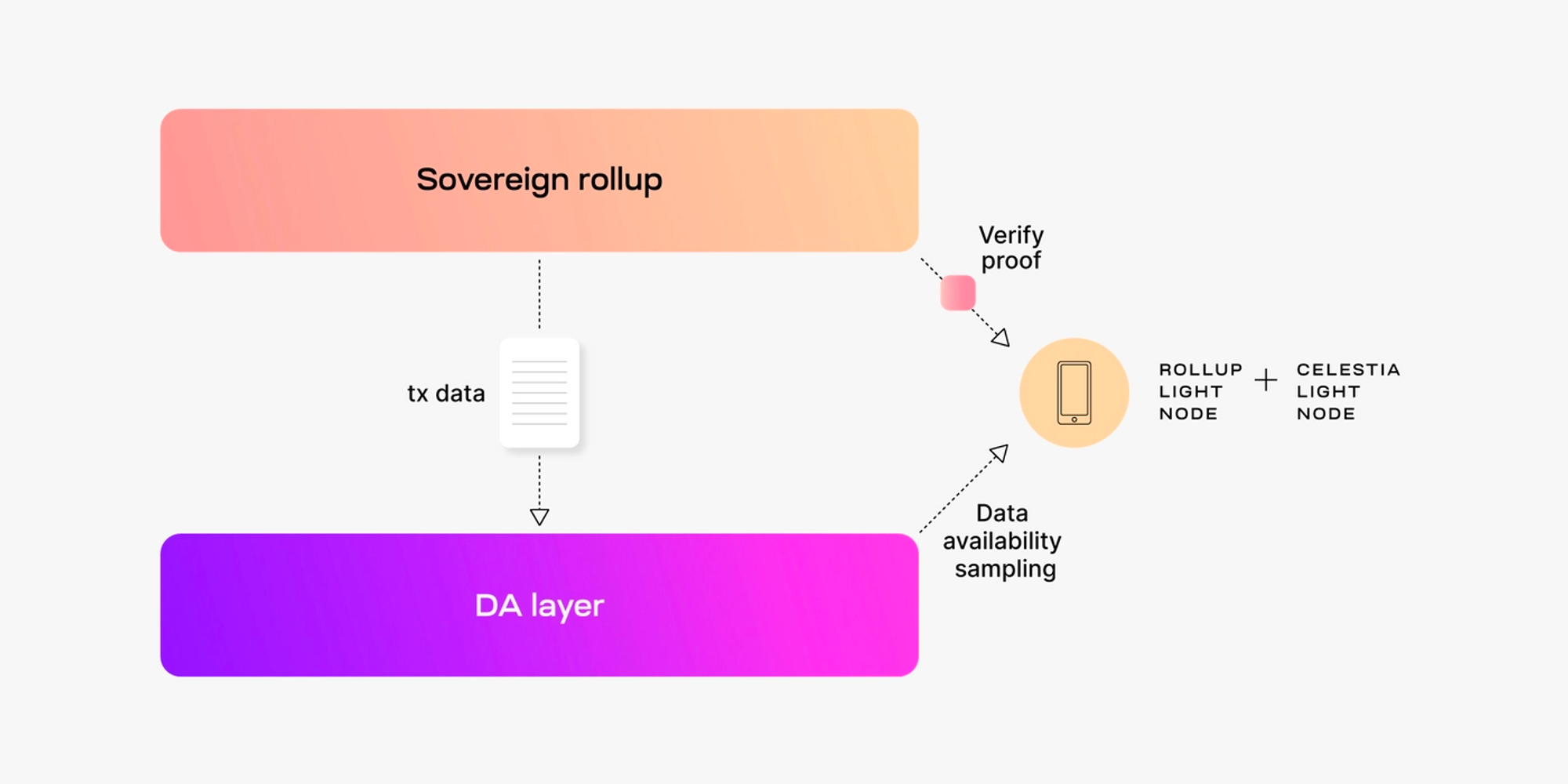
For smart contract rollup, the upgrade depends on the smart contract on the settlement layer. Upgrading Rollup requires changes to the smart contract. Multi-signatures may be required to control who can initiate updates to smart contracts. Although it is common for teams to control upgrades to multi-signature, it is possible to make multi-signature controlled through governance. Since smart contracts exist on the settlement layer, they are also subject to the social consensus of the settlement layer.
Sovereign Rollup upgrades through forks like layer 1 blockchains. New software versions are released and nodes can choose to update their software to the latest version. If nodes dont agree to the upgrade, they can continue to use the old software. Provide the option to let the community, i.e. the people running the nodes, decide whether they agree with the new changes. Even if a majority of nodes are upgraded, they cannot be forced to accept the upgrade. Compared with smart contract rollup, this feature makes sovereign rollup a sovereign rollup.
Quantum Gravity Bridge (QGB):A key component of the Celestia ecosystem, it serves as a bridge between Celestia and Ethereum (or other EVM L1 chains), enabling the transfer of data and assets between the two networks. By introducing the concept of Celestium (EVM L2 Rollup), using Celestia for data availability, but settlement on Ethereum. This allows you to leverage the advantages of two networks simultaneously: the scalability and data availability of Celestia, and the security and decentralization of Ethereum.
Validators on Celestia can run QGB, allowing Celestium to provide strong data availability guarantees for block data at a fraction of the cost of Ethereums Calldata.
QGB serves as a key part of Celestias vision of a scalable, secure and decentralized blockchain ecosystem. It enables the interoperability required for the future of blockchain technology. The project is currently still producing Zk QGB to further reduce the gas cost of verification.
DA Economics
Let’s talk about the economic value of DA.

This assumption is based on Polygon Hermez’s prediction that they will only need 14 bytes per transaction in the end. Under the current Danksharding specification of 1.3 MB/s, Laeyr 2’s TPS can reach about 100,000, and the estimated revenue will reach an astonishing US$30 billion. number.
With such a huge cake, the future disputes in the DA market will be very fierce. In addition to the three mainstream solutions, Starks split scaling Layer 3, zkPorter, and multiple modular DA projects will join the war. So judging from the existing Layer 2 projects, the general chain is completely inclined to use Ethereum DA. Application chains and long-tail chains will be the main customers of “unorthodox DA”. My personal opinion is that modular DA and soon Layer 3 will become the mainstream choice in the future.
Conclusion
Advancing decentralization is still the mainstream concept in this industry. Modular blockchain is essentially an extension of the value of Ethereum and an attempt to break the impossible triangle of blockchain. Although the design is full of diversity, it is also Makes the build more cumbersome and complex. In modular construction, since the modules have multiple options, the risks of different modules are a blind box. How to build a more stable modular system is something that needs to be paid attention to. On the other hand, driven by the trend of modularization, dozens of Layer 2 will also fragment liquidity again, and cross-chain communication and security will also be the focus in the future. The modularization of BTC is also a hot trend recently, and there are some slightly feasible solutions, which can also be paid attention to.



